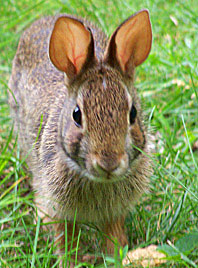Rabbits in Your Garden
Rabbit Damage to Plants and Beds
Rabbits are attractive animals, so much so that many children like to keep them as pets.
They win our support, even when they are going about their natural destructive behaviour, hence the enduring popularity of Beatrix Potter's children's books that feature Peter Rabbit as the "hero".
They may appear to be gentle furry attractive creatures but when they enter your garden as uninvited guests, they will help themselves to anything that takes their fancy.
In reality, rabbits can multiply very quickly and are capable of causing extensive damage in the garden.
If small numbers of rabbits start to visit your vegetable plot, you are likely to notice that the ends of rows are being nibbled away. That's the time to act because once they invade in significant numbers, nothing will be safe. They will eat almost any green vegetation as soon as it appears above ground.
Rabbits love vegetable plants such as carrots, lettuce, beans and peas, which are often the mainstay of vegetable gardeners and allotment keepers. However, they are also partial to many ornamental plants, flowers and grasses.
They will also damage much larger plants. For example, they enjoy gnawing at the bark of young trees, both ornamental and fruit trees. If this is allowed to progress, of course, they are perfectly capable of killing the tree.
Plants are most at risk from attack by rabbits when they are young and succulent. They tend to be less attractive once plants have grown beyond the seedling stage and when the bark of trees has grown to be much tougher.
In addition to destroying plant life, rabbits can also cause erosion by their tunnelling habits, which may be for the purpose of making a home or to gain access to areas that they cannot reach above ground.
Read Also:
General Measures for Controlling Rabbits

You may wish to consider a variety of approaches for minimising damage from rabbits including, for example:
- Erecting barriers to deny access to your garden
- Forms of pest repellent that make your garden less attractive to rabbits and encourages them to go elsewhere to find their dinner
- Planting patches of vegetation that is particularly appetizing to rabbits (such as clover) and that you are happy to sacrifice as a distraction from your prized plants.
- Trapping or killing rabbits, preferably in a humane manner.
Depending on how serious the problem has become, you may choose to adopt a combination of measures that will reduce the damage to acceptable levels.
Physical Barriers to Control Rabbits
Guarding the Whole Garden
Fencing off the garden, or the part of your garden that is most susceptible to attack, is perhaps one of the most effective deterrents, though it can be expensive.
A wire netting fence around the garden can be effective. It needs to be a couple of feet high and tucked into the ground to reduce the possibility of rabbits burrowing underneath. A couple of inches buried below ground should be sufficient to deter most rabbits, but if you really want to be sure, opt for six inches or more.
A word of caution is in order though. It may be that your problem is not rabbits but from their larger cousin the hare. If you think this might be the case, then you need to increase the height of your netting to around three feet to be effective.
An alternative to burying the netting is to bend a section so that it lays outward and flat to the ground. This section should be about a foot wide and then secured to the ground by pegs or by using substantial weights. This should provide sufficient defence against those rabbits that attempt to burrow under the main fence.
Ordinary wire netting will do, though if budget permits, green plastic coated netting may blend in better and improve the appearance. Whichever type you use, ensure the mesh size is small enough (one inch or less) to prevent younger rabbits from squeezing through.
If you adopt this approach, you must ensure every point of access to your garden is covered and you will need to examine the fence on a routine basis for any damage. Rabbits will find even the smallest breach, probably before you do, so if you notice new damage to your crops, it is time for a close inspection of your defences.
Guarding Individual Plants
An alternative to fencing round the boundary of the garden is to protect individual plants. In fact, both approaches can be used in combination for maximum protection. If you have access to large tin cans (such as those used in catering), you can remove the tops and bottoms and then stand them around young plants.
In similar fashion, you can protect young trees by fabricating cylinders from strong polythene or similar material, held together with staples.
